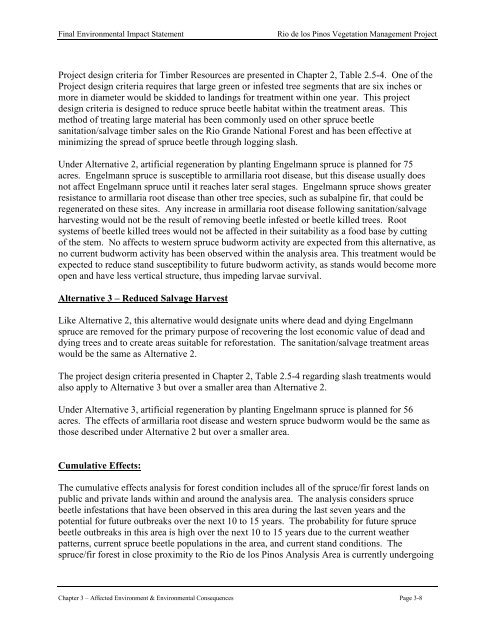Final Environmental Impact Statement Rio de los Pinos Vegetation ...
Final Environmental Impact Statement Rio de los Pinos Vegetation ...
Final Environmental Impact Statement Rio de los Pinos Vegetation ...
You also want an ePaper? Increase the reach of your titles
YUMPU automatically turns print PDFs into web optimized ePapers that Google loves.
<strong>Final</strong> <strong>Environmental</strong> <strong>Impact</strong> <strong>Statement</strong> <strong>Rio</strong> <strong>de</strong> <strong>los</strong> <strong>Pinos</strong> <strong>Vegetation</strong> Management Project<br />
Project <strong>de</strong>sign criteria for Timber Resources are presented in Chapter 2, Table 2.5-4. One of the<br />
Project <strong>de</strong>sign criteria requires that large green or infested tree segments that are six inches or<br />
more in diameter would be skid<strong>de</strong>d to landings for treatment within one year. This project<br />
<strong>de</strong>sign criteria is <strong>de</strong>signed to reduce spruce beetle habitat within the treatment areas. This<br />
method of treating large material has been commonly used on other spruce beetle<br />
sanitation/salvage timber sales on the <strong>Rio</strong> Gran<strong>de</strong> National Forest and has been effective at<br />
minimizing the spread of spruce beetle through logging slash.<br />
Un<strong>de</strong>r Alternative 2, artificial regeneration by planting Engelmann spruce is planned for 75<br />
acres. Engelmann spruce is susceptible to armillaria root disease, but this disease usually does<br />
not affect Engelmann spruce until it reaches later seral stages. Engelmann spruce shows greater<br />
resistance to armillaria root disease than other tree species, such as subalpine fir, that could be<br />
regenerated on these sites. Any increase in armillaria root disease following sanitation/salvage<br />
harvesting would not be the result of removing beetle infested or beetle killed trees. Root<br />
systems of beetle killed trees would not be affected in their suitability as a food base by cutting<br />
of the stem. No affects to western spruce budworm activity are expected from this alternative, as<br />
no current budworm activity has been observed within the analysis area. This treatment would be<br />
expected to reduce stand susceptibility to future budworm activity, as stands would become more<br />
open and have less vertical structure, thus impeding larvae survival.<br />
Alternative 3 – Reduced Salvage Harvest<br />
Like Alternative 2, this alternative would <strong>de</strong>signate units where <strong>de</strong>ad and dying Engelmann<br />
spruce are removed for the primary purpose of recovering the <strong>los</strong>t economic value of <strong>de</strong>ad and<br />
dying trees and to create areas suitable for reforestation. The sanitation/salvage treatment areas<br />
would be the same as Alternative 2.<br />
The project <strong>de</strong>sign criteria presented in Chapter 2, Table 2.5-4 regarding slash treatments would<br />
also apply to Alternative 3 but over a smaller area than Alternative 2.<br />
Un<strong>de</strong>r Alternative 3, artificial regeneration by planting Engelmann spruce is planned for 56<br />
acres. The effects of armillaria root disease and western spruce budworm would be the same as<br />
those <strong>de</strong>scribed un<strong>de</strong>r Alternative 2 but over a smaller area.<br />
Cumulative Effects:<br />
The cumulative effects analysis for forest condition inclu<strong>de</strong>s all of the spruce/fir forest lands on<br />
public and private lands within and around the analysis area. The analysis consi<strong>de</strong>rs spruce<br />
beetle infestations that have been observed in this area during the last seven years and the<br />
potential for future outbreaks over the next 10 to 15 years. The probability for future spruce<br />
beetle outbreaks in this area is high over the next 10 to 15 years due to the current weather<br />
patterns, current spruce beetle populations in the area, and current stand conditions. The<br />
spruce/fir forest in c<strong>los</strong>e proximity to the <strong>Rio</strong> <strong>de</strong> <strong>los</strong> <strong>Pinos</strong> Analysis Area is currently un<strong>de</strong>rgoing<br />
Chapter 3 – Affected Environment & <strong>Environmental</strong> Consequences Page 3-8
















